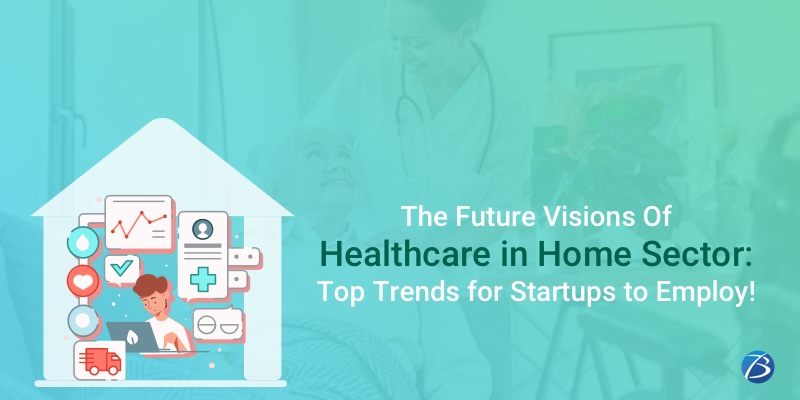The Future Visions of Healthcare in Home Sector: Top Trends for Startups to Employ!


It is interesting to watch how the healthcare sector has evolved over the years. In the 1950s, physicians and doctors would make calls to the patients for delivering the best possible healthcare services to them. And today, in the year 2021, this trend seems to have returned where the doctors and physicians are reaching out to the patients, for providing them the best patient experience.
Moreover, the home care providing industry is growing leaps and bounds in the United States. The top reasons behind the revenue growth of this industry are the aging population in the US, rising acceptance of home care, the prevalence of chronic health conditions, technological advancements, etc. Home care also saves a lot of costs as compared to hospital care treatment. Needless to say, the future of the healthcare sector is going to be much more patient-oriented and going to save much more lives than ever.
Here are some predictions by Deloitte, on how will the future of healthcare look like in the coming years.
- Healthcare practices will start shifting from treating illnesses to prevention and patient well-being.
- Patient engagement and their empowerment will give them a sense of ownership of their health.
- Interoperable data and related platforms will allow vital medical data to flow freely yet securely for insightful decision-making.
These predictions depict that technology is going to advance the healthcare systems in myriad ways. Besides, startups and healthcare app development agencies will accordingly design their healthcare products. New trends will come into the picture and these startups and development services will have to accustom to those trends. So, let’s have a glimpse at some of such future-oriented trends.
The Future Visions of Healthcare Sector: Top Trends for Startups to Observe
Aging Patients and Home Care
According to a survey, 3 out of 4 adults of the age 50 or above would want to stay at their homes and with people of their community. As per another survey, almost 10,000 Baby Boomers are crossing the age mark of 65 years in the US; Baby Boomers are those people born between the years 1946 to 1964 and they have a considerable impact on the US economy. Besides, the number of people aged above 65 years will cross 18% of the total population, by the year 2030.
So, it is estimated that home care will be in high demand in the future. To support this statement, there is another report which predicts that by 2024, the U.S. home care market could cross $225 Billion, which was $100 Billion in the year 2016. So altogether, this is a great time for budding entrepreneurs and startups to leverage this opportunity to design apt on-demand health care app development solutions that can bridge this health care gap to offer superior medical services.
Doctors Connecting with Patients
This is the era of serving the consumers on-demand at their desired location. This holds true for the healthcare sector too. Doctors connecting to the patients and taking house calls is going to be the new norm and it is going to be the future of all kinds of healthcare entities.
There already have been some medical applications in the market that offer features like audio/video calling and digital monitoring services. MeetYourDoc is one such telemedicine app. It allows patients and doctors to connect through video sessions for remote treatments.
Also, there are some other applications that are trying to bring at-home care to several patients. Phlex65 is one of the best HIPAA compliant apps meant for both- aged people and care providers. Older people can hire at-home care providers from nearby areas through Phlex65.
Telemedicine and its Convenience
Telemedicine facilitates patient monitoring using a smartphone or tablet or PC and helps the patients get medical help without moving to a hospital or a clinic. Telemedicine is a technology-driven approach that is serving millions of patients, especially in rural areas where there is a scarcity of medical facilities. Not only rural patients but owing to the current pandemic situation, even urban patients have started preferring telemedicine facilities. With just a click of a button, patients can avail these services and avoid long wait times in hospitals, or get rid of the traveling time and cost. So, the telemedicine industry, too, is growing at a rapid pace and every healthcare app development company in USA must consider this as an opportunity to grow their business.
Are You Interested in Building a Top-Class Website or Mobile App?
Final Thoughts
Future visions of the healthcare domain clearly notify that ‘personalized treatment’ and ‘remote care’ are going to be the new normal, and to some extent, they have already been implemented by many care providers. With the advent of digital healthcare technologies, a plethora of mHealth apps and healthcare management systems have been designed to deliver the best-in-class patient experience and provide personalized services to them.
Furthermore, these healthcare systems and services drive actionable insights into the health conditions of patients, improve communication between patients and doctors, and provide the patients all the information about their health. So, it is essential for the startups to keep a keen watch on all such trends and accordingly design their healthcare products or offer healthcare app development services.
That’s it in this post. Hope it provided you with some thoughtful trends and ideas.
If you want more details on how this sector is advancing, reach out to us. Our professionals will assist you on this, and also guide you if you are looking forward to creating such medical apps or systems.



